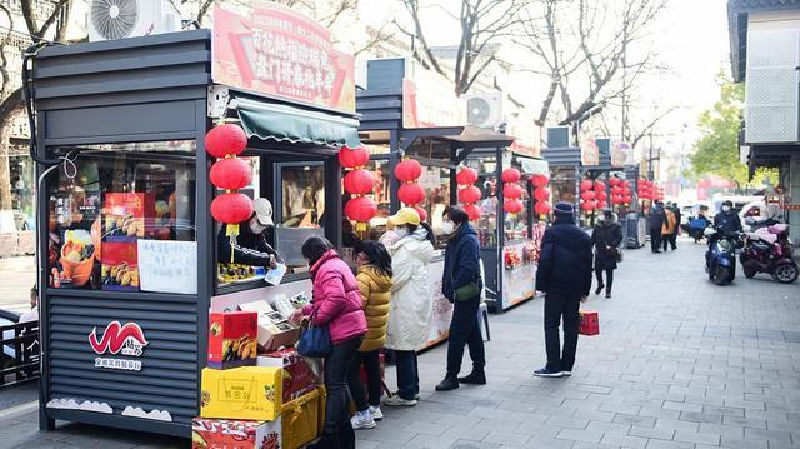China and Covid19
Chinese Online Discussions on the Origins of Covid-19 after FBI Statement on Wuhan Lab Leak
After the FBI suggested it is likely that Covid-19 originated in a Wuhan lab, commentator Hu Xijin posted about “the United States of Rumors.”
Published
1 year agoon
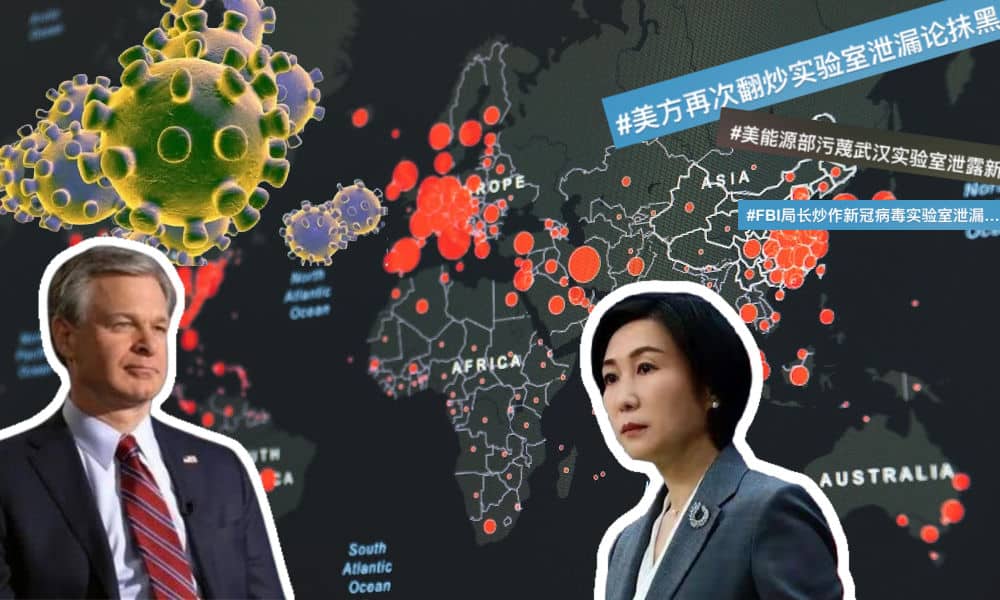
Is it a political issue or a scientific problem? The recent FBI statements on the origin of Covid-19 have brought the lab leak theory back on the table and, once again, triggered political blameshifting and online discussions about the roots of the pandemic.
Over three years since Covid-19 was first discovered in Wuhan and was linked to the local Huanan Seafood Market, the debate on the roots of the Covid-19 pandemic is still ongoing and has again made headlines this week as FBI director Christopher Wray endorsed a theory that the Covid pandemic was a result of a laboratory leak in China.
Wray’s remarks came after a Wall Street Journal report about an updated classified intelligence report from the United States Department of Energy. That report concluded that the pandemic probably – with “low-confidence” assessment – started with an unintentional lab leak in Wuhan.
China’s Foreign Ministry responded to the issue during a regular press conference earlier this week, blaming the Americans for using the problem regarding the origins of SARS‑CoV‑2 (the strain of coronavirus that causes Covid-19) for “political manipulation” (“政治操弄”). Spokesperson Mao Ning (毛宁) also said that the claims lacked credibility and were simply politicizing the issue instead of taking a scientific approach.
LAB LEAK THEORIES
“Although many lab leak conspiracy theories started in the U.S., some also began on the Chinese internet.”
Over the past years, discussions over the origins of SARS-CoV-2 have become increasingly politicized and both American and Chinese sides have pointed the finger at each other and shifted blame for the spread of the virus and the pandemic response on both sides.
Speculations, rumors, and theories that Covid-19 may have emerged from a laboratory in Wuhan were first raised in early 2020. Although many of these lab leak conspiracy theories started in the U.S., some also began on the Chinese internet.
In February of 2020, a rumor circulated on Chinese social media that a postgraduate named Yanling Huang from the high-security lab Wuhan Institute of Virology was the “Patient Zero” of Covid-19 (Wang et al 2021, 73). This was determined to be false, and other similar rumors making their rounds were also refuted and sidelined as a “conspiracy theory” by many scientists.1
A statement in The Lancet published in February of 2020 condemned any rumors on the virus origins, claiming that scientific research “overwhelmingly” concludes that the new coronavirus originated in wildlife.
The World Health Organization (WHO) research team investigating the origins of Covid-19, and which visited China in January of 2021, also called it “extremely unlikely” that the virus leaked from a lab in China. At the same time, all hypotheses on the origin of the virus remained on the table, and later on in 2021, the debate intensified after American President Biden called for a next phase study into the origins of the virus.
Dr. Fauci, director of the American National Institute of Allergy and Infectious Diseases, had been among scientists who originally refuted the ‘lab leak’ theory, but in May of 2021, he changed his tune and said he was “no longer convinced” that the Covid-19 pandemic originated naturally.
The Chinese official side has consistently refuted claims that Covid-19 might have come from a Chinese laboratory leak, saying it is all about “political manipulation” and “blame shifting.”
China’s Foreign Ministry has turned the tables on the U.S. multiple times, demanding a thorough investigation into the source of the epidemic in the United States and a further probe into safety concerns at Fort Detrick and other American biological labs.
COVID-19 ORIGINS: HARDER TO TRACE
“The Covid-19 origin debate remains to be both a political and a scientific conundrum.”
Important keys to the SARS-CoV-2 origin question seem caught in a web of strategic narratives, political games, and colored perspectives.
Despite the recent U.S. Department of Energy report, there is still consensus among scientists – supported by a substantial body of research – that SARS-CoV-2 is of zoonotic origin, although the specific animal host has not been identified.
A study published in Science in July of 2022 concludes that SARS-Cov-2 most likely jumped from animals to humans at the Huanan Seafood Wholesale Market back in December 2019 (Worobey et al 2022).
Other recent studies that have come out on the research surrounding the origins of the Covid-19 pandemic argue that the complexity of the virus and the lack of harmonious international cooperation are making it harder to draw definite conclusions. Since the research requires international data from 2019 and is time-sensitive, the delays are also making it more tricky to identify the source of SARS-CoV-2 (see Hao et al 2022, 3189-3190).
The official Chinese stance (August 2021) is that the virus is of zoonotic origin and that China supports scientific research into the sources of the virus, as long as this does not become a political tool. The Chinese side also stresses that the fact that the virus was first discovered in Wuhan does not mean that the “Patient Zero” was also in Wuhan, as some studies indicate that there were positive Covid-19 cases before December 2019 in America, Brazil, and Italy (Hao et al 2022, 3185-3186).
In May of 2022, Chinese researchers published a blood-donors study analyzing samples supplied to the Wuhan Blood Center before December 2019, researching if there were SARS-Cov-2 antibodies in the blood provided between Sept-Dec of that year. That study reportedly did not find antibodies amid over 88,000 samples, showing the virus was not widespread in Wuhan in late 2019 (Chang et al 2023; Mallapaty 2023).
With so many questions left unanswered, a second phase study by the WHO into the origins of Covid-19 was much-anticipated. But it recently became known that the WHO shelved this investigation. According to Nature, the stalling of the research relates to ongoing challenges over attempts to conduct crucial studies in China.
And so the Covid-19 origin debate remains to be both a political and a scientific conundrum. Some scientists have voiced concerns that the FBI statement could lead to a renewed wave of harassment against scientists, with such statements only further clouding the debate instead of contributing to it (Euronews).
WEIBO DISCUSSIONS
“As long as politics and science cannot operate independently of each other, there is no conclusion in sight.”
Although the Chinese side supposedly condemns blame-shifting and finger-pointing in the Covid-19 origins issue, the media-led and official online discourse regarding the ‘origins problem’ is mostly accusing the U.S. of hyping the issue and making China the scapegoat. Various Weibo hashtags that are used in posts about the topic literally include the words “hyping” and “politicizing” (#美方应该停止搞政治溯源情报溯源#, #美方再次翻炒实验室泄漏论抹黑不了中国#, #有关方面应停止对新冠溯源政治化#, #FBI局长炒作新冠病毒实验室泄漏论#).
Well-known political commentator Sima Nan (@司马南) accused the American side of dredging up and repeating the same old issues again and that the U.S. is “increasingly becoming the world’s laughingstock” for spreading rumors via its official and media channels.
On March 3rd, another Chinese political commentator, Hu Xijin (@胡锡进) also published about the issue, again raising the issue of how Fort Detrick and a lab leak may be connected to the roots of the pandemic:
“In China, there are also many people who think that Covid-19 could come from a laboratory, but that it is America’s Fort Detrick lab. The WHO experts have already visited the Wuhan lab, but the expert group still has not visited the Fort Detrick lab despite the serious doubts about a Covid lab leak there. If the U.S. has nothing to hide, then it should do what China did in 2021 and open the doors of Fort Detrick to the WHO. The biggest lie in human history is that of former U.S. Secretary of State Colin Powell holding a bottle of washing powder at the United Nations and saying it was an Iraqi chemical weapon. That lie was used as pretext to launch a bloody war. The United States should change its name to “the United States of Rumors” (“谣言合众国”).”
One of the top replies on Hu’s post mentioned the American “vaping disease” that broke out in 2019 and peaked in September of that year. “It must have been the Yankees,” another commenter wrote.
The claim that Fort Detrick is related to the start of the pandemic or that the U.S. army brought Covid-19 to Wuhan has already been circulating since 2020, and these speculations were strengthened by Chinese official sources, including Foreign Ministry spokesperson Zhao Lijian, that pointed the finger at the U.S.
Many online discussions on Chinese social media, including those on Q&A platform Zhihu.com, still accuse the United States for covering up Covid-related facts and for putting the blame on China to cover their own tracks.
In light of the recent balloon controversy, some called the latest statements “another balloon.” By now, it seems impossible to separate the problem of Covid-19 origins from the bilateral relationships between China and the U.S. anymore.
In this regard, the online discussions surrounding the origins of Covid-19 have not changed a lot since 2020. It is a bit of a Catch-22, since these discussions are politicized as they are focused on how the U.S. is politicizing the issue. As long as (international) politics and science cannot operate independently of each other, there is no conclusion in sight that will bring the discussion on the exact origin of Covid-19 to a definitive end.
By Manya Koetse
1 Besides the Wuhan Institute of Virology, the Wuhan-based Chinese Center for Disease Control has also been considered a possible source of a lab leak – the latter is also the one mentioned in the U.S. Department of Energy report.
References
Chang, Le, Lei Zhao, Yan Xiao, Tingting Xu, Lan Chen, Yan Cai, Xiaojing Dong et al. 2023. “Serosurvey for SARS-CoV-2 among blood donors in Wuhan, China from September to December 2019.” Protein & Cell 14 (1): 28-36.
Hao, Ying-Jian, and Yu-Lan Wang. 2022. “The origins of COVID-19 pandemic: A brief overview.” Transboundary and Emerging Diseases (69): 3181–3197.
Khatsenkova, Sophia. 2023. “China COVID lab leak: What we know and what we don’t know about the origins of the virus.” Euronews, # March https://www.euronews.com/next/2023/03/02/china-covid-lab-leak-what-we-know-and-what-we-dont-know-about-the-origins-of-the-virus [4 March 2023].
Mallapaty, Smriti. 2023. “WHO abandons plans for crucial second phase of COVID-origins investigation.” Nature, 14 February (Updated 3 March) https://www.nature.com/articles/d41586-023-00283-y#ref-CR1 [4 March 2023].
Wang, Xin, Fan Chao, Guang Yu. 2021. “Evaluating Rumor Debunking Effectiveness During the Covid-19 Pandemic Crisis: Utilizing User Stance in Comments on Sina Weibo.” Frontiers in Public Health (9): 70-87.
Worobey, Michael, Joshua Levy, Lorena Serrano, Alexander Crits-Christoph, Jonathan Pekar, Stephen Goldstein, Angela Rasmussen, Moritz Kraemer, Chris Newman, Marion Koopmans, Marc Suchard, Joel Wertheim, Philippe Lemey, David Robertson, Robert Garry, Edward Holmes, Andrew Rambaut, Kristian Andersen. 2022. “The Huanan Seafood Wholesale Market in Wuhan was the early epicenter of the COVID-19 pandemic.” Science 377 (6609): 951-959.
Featured image:
Background image by Martin Sanchez.
Get the story behind the hashtag. Subscribe to What’s on Weibo here to receive our newsletter and get access to our latest articles:
Spotted a mistake or want to add something? Please let us know in comments below or email us. First-time commenters, please be patient – we will have to manually approve your comment before it appears.
©2023 Whatsonweibo. All rights reserved. Do not reproduce our content without permission – you can contact us at info@whatsonweibo.com.
Manya Koetse is the founder and editor-in-chief of whatsonweibo.com. She is a writer, public speaker, and researcher (Sinologist, MPhil) on social trends, digital developments, and new media in an ever-changing China, with a focus on Chinese society, pop culture, and gender issues. She shares her love for hotpot on hotpotambassador.com. Contact at manya@whatsonweibo.com, or follow on Twitter.
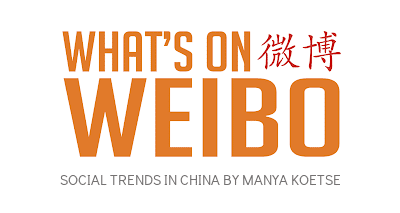
Also Read
China and Covid19
Sick Kids, Worried Parents, Overcrowded Hospitals: China’s Peak Flu Season on the Way
“Besides Mycoplasma infections, cases include influenza, Covid-19, Norovirus, and Adenovirus. Heading straight to the hospital could mean entering a cesspool of viruses.”
Published
8 months agoon
November 22, 2023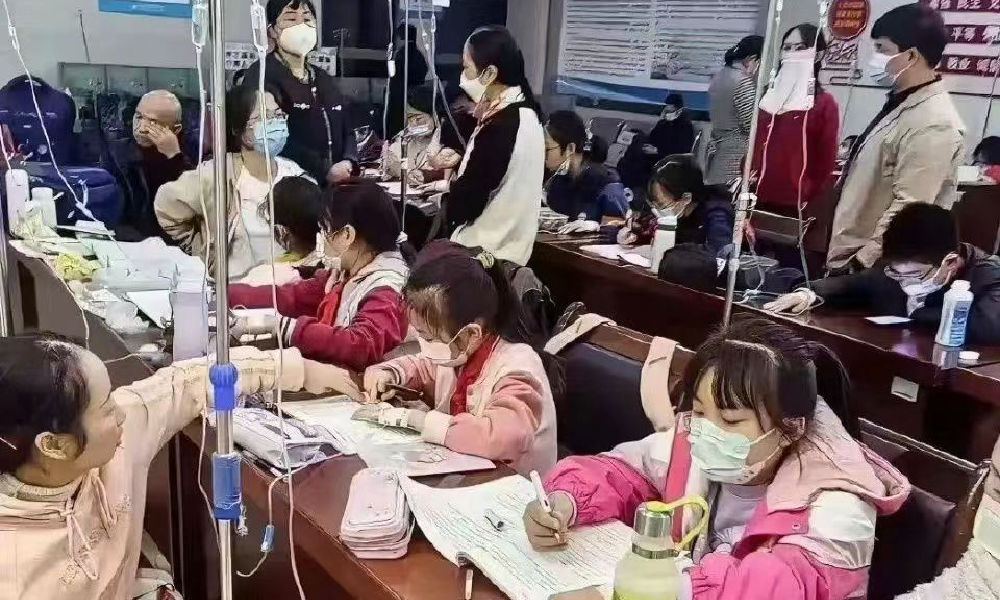
In the early morning of November 21, parents are already queuing up at Xi’an Children’s Hospital with their sons and daughters. It’s not even the line for a doctor’s appointment, but rather for the removal of IV needles.
The scene was captured in a recent video, only one among many videos and images that have been making their rounds on Chinese social media these days (#凌晨的儿童医院拔针也要排队#).
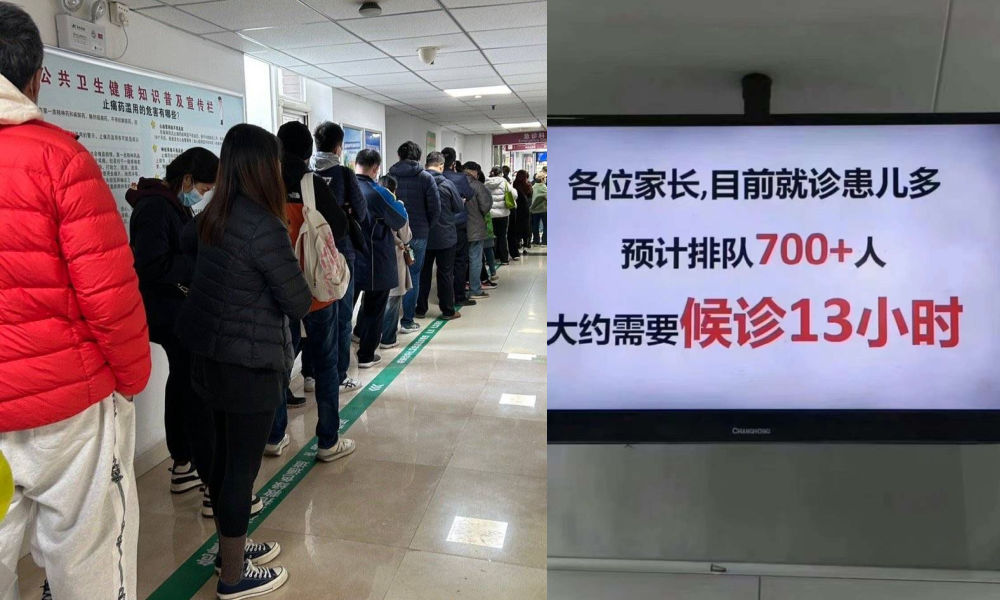
One photo shows a bulletin board at a local hospital warning parents that over 700 patients are waiting in line, estimating a waiting time of more than 13 hours to see a doctor.
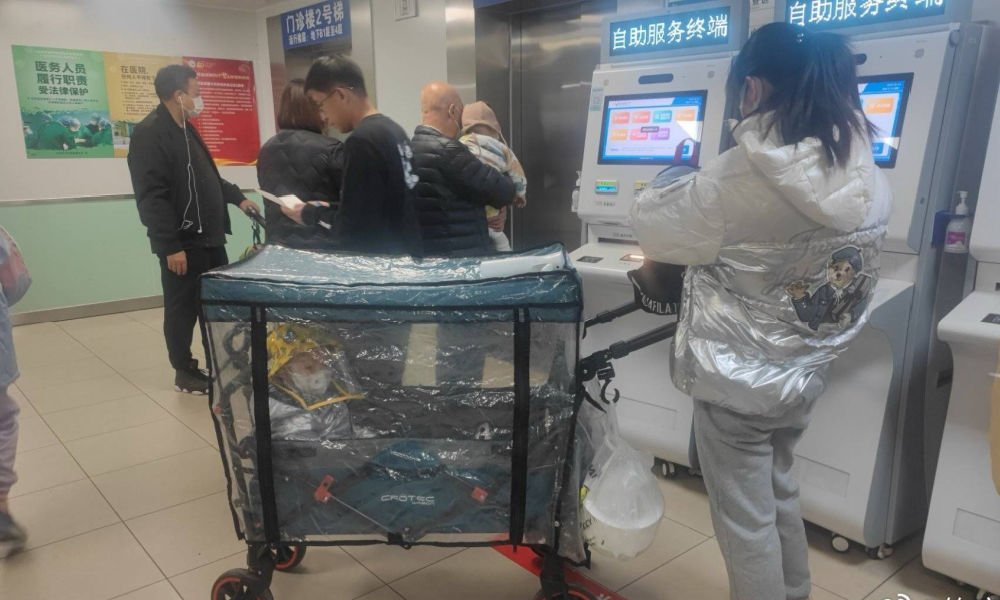
Another image shows children doing their homework while hooked up on an IV.

Recent discussions on Chinese social media platforms have highlighted a notable surge in flu cases. The ongoing flu season is particularly impacting children, with multiple viruses concurrently circulating and contributing to a high incidence of respiratory infections.
Among the prevalent respiratory infections affecting children are Mycoplasma pneumoniae infections, influenza, and Adenovirus infection.
The spike in flu cases has resulted in overcrowded children’s hospitals in Beijing and other Chinese cities. Parents sometimes have to wait in line for hours to get an appointment or pick up medication.
According to one reporter at Haibao News (海报新闻), there were so many patients at the Children’s Hospital of Capital Institute of Pediatrics (首都儿科研究所) on November 21st that the outpatient desk stopped accepting new patients by the afternoon. Meanwhile, 628 people were waiting in line to see a doctor at the emergency department.
Reflecting on the past few years, the current flu season marks China’s first ‘normal’ flu peak season since the outbreak of Covid-19 in late 2019 / early 2020 and the end of its stringent zero-Covid policies in December 2022. Compared to many other countries, wearing masks was also commonplace for much longer following the relaxation of Covid policies.
Hu Xijin, the well-known political commentator, noted on Weibo that this year’s flu season seems to be far worse than that of the years before. He also shared that his own granddaughter was suffering from a 40 degrees fever.
“We’re all running a fever in our home. But I didn’t dare to go to the hospital today, although I want my child to go to the hospital tomorrow. I heard waiting times are up to five hours now,” one Weibo user wrote.
“Half of the kids in my child’s class are sick now. The hospital is overflowing with people,” another person commented.
One mother described how her 7-year-old child had been running a fever for eight days already. Seeking medical attention on the first day, the initial diagnosis was a cold. As the fever persisted, daily visits to the hospital ensued, involving multiple hours for IV fluid administration.
While this account stems from a single Weibo post within a fever-advice community, it highlights a broader trend: many parents swiftly resort to hospital visits at the first signs of flu or fever. Several factors contribute to this, including a lack of General Practitioners in China, making hospitals the primary choice for medical consultations also in non-urgent cases.
There is also a strong belief in the efficacy of IV infusion therapy, whether fluid-based or containing medication, as the quickest path to recovery. Multiple factors contribute to the widespread and sometimes irrational use of IV infusions in China. Some clinics are profit-driven and see IV infusions as a way to make more money. Widespread expectations among Chinese patients that IV infusions will make them feel better also play a role, along with some physicians’ lacking knowledge of IV therapy or their uncertainty to distinguish bacterial from viral infections (read more here)
To prevent an overwhelming influx of patients to hospitals, Chinese state media, citing specialists, advise parents to seek medical attention at the hospital only for sick infants under three months old displaying clear signs of fever (with or without cough). For older children, it is recommended to consult a doctor if a high fever persists for 3 to 5 days or if there is a deterioration in respiratory symptoms. Children dealing with fever and (mild) respiratory symptoms can otherwise recover at home.
One Weibo blogger (@奶霸知道) warned parents that taking their child straight to the hospital on the first day of them getting sick could actually be a bad idea. They write:
“(..) pediatric departments are already packed with patients, and it’s not just Mycoplasma infections anymore. Cases include influenza, Covid-19, Norovirus, and Adenovirus. And then, of course, those with bad luck are cross-infected with multiple viruses at the same time, leading to endless cycles. Therefore, if your child experiences mild coughing or a slight fever, consider observing at home first. Heading straight to the hospital could mean entering a cesspool of viruses.”
The hashtag for “fever” saw over 350 million clicks on Weibo within one day on November 22.
Meanwhile, there are also other ongoing discussions on Weibo surrounding the current flu season. One topic revolves around whether children should continue doing their homework while receiving IV fluids in the hospital. Some hospitals have designated special desks and study areas for children.
Although some commenters commend the hospitals for being so considerate, others also remind the parents not to pressure their kids too much and to let them rest when they are not feeling well.
Opinions vary: although some on Chinese social media say it's very thoughtful for hospitals to set up areas where kids can study and read, others blame parents for pressuring their kids to do homework at the hospital instead of resting when not feeling well. pic.twitter.com/gnQD9tFW2c
— Manya Koetse (@manyapan) November 22, 2023
By Manya Koetse, with contributions from Miranda Barnes
Get the story behind the hashtag. Subscribe to What’s on Weibo here to receive our newsletter and get access to our latest articles:
Spotted a mistake or want to add something? Please let us know in comments below or email us. First-time commenters, please be patient – we will have to manually approve your comment before it appears.
©2023 Whatsonweibo. All rights reserved. Do not reproduce our content without permission – you can contact us at info@whatsonweibo.com.
China and Covid19
Repurposing China’s Abandoned Nucleic Acid Booths: 10 Innovative Transformations
Abandoned nucleic acid booths are getting a second life through these new initiatives.
Published
1 year agoon
May 19, 2023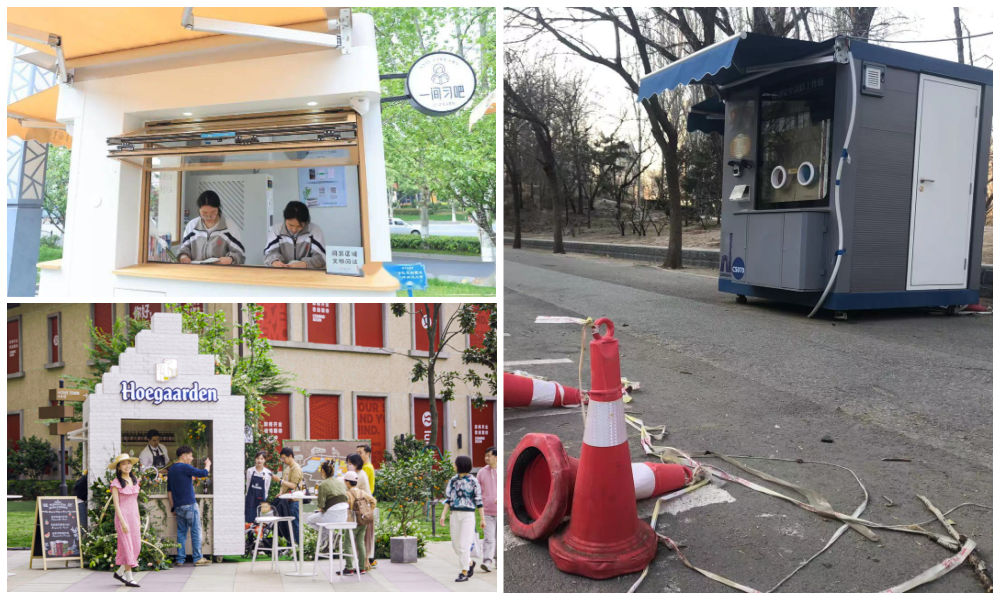
During the pandemic, nucleic acid testing booths in Chinese cities were primarily focused on maintaining physical distance. Now, empty booths are being repurposed to bring people together, serving as new spaces to serve the community and promote social engagement.
Just months ago, nucleic acid testing booths were the most lively spots of some Chinese cities. During the 2022 Shanghai summer, for example, there were massive queues in front of the city’s nucleic acid booths, as people needed a negative PCR test no older than 72 hours for accessing public transport, going to work, or visiting markets and malls.
The word ‘hésuān tíng‘ (核酸亭), nucleic acid booth (also:核酸采样小屋), became a part of China’s pandemic lexicon, just like hésuān dìtú (核酸地图), the nucleic acid test map lauched in May 2022 that would show where you can get a nucleic test.
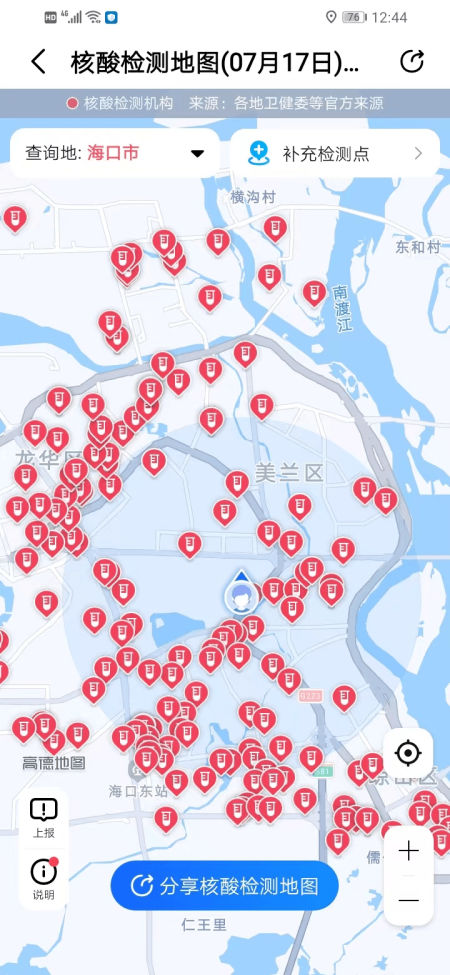
Example of nucleic acid test map.
During Halloween parties in Shanghai in 2022, some people even came dressed up as nucleic test booths – although local authorities could not appreciate the creative costume.
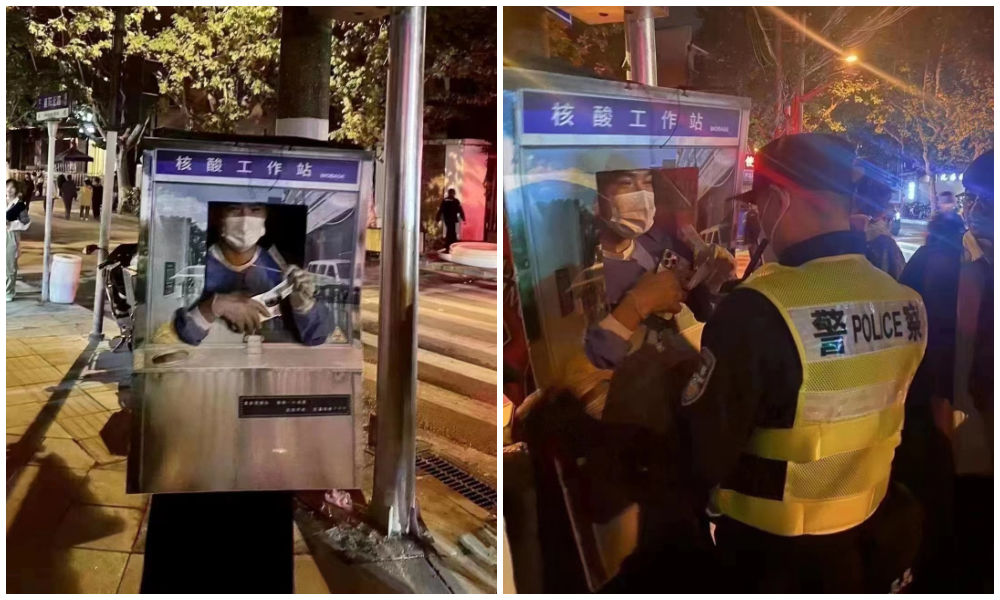
Halloween 2022: dressed up as nucliec acid booths. Via @manyapan twitter.
In December 2022, along with the announced changed rules in China’s ‘zero Covid’ approach, nucleic acid booths were suddenly left dismantled and empty.
With many cities spending millions to set up these booths in central locations, the question soon arose: what should they do with the abandoned booths?
This question also relates to who actually owns them, since the ownership is mixed. Some booths were purchased by authorities, others were bought by companies, and there are also local communities owning their own testing booths. Depending on the contracts and legal implications, not all booths are able to get a new function or be removed yet (Worker’s Daily).
In Tianjin, a total of 266 nucleic acid booths located in Jinghai District were listed for public acquisition earlier this month, and they were acquired for 4.78 million yuan (US$683.300) by a local food and beverage company which will transform the booths into convenience service points, selling snacks or providing other services.
Tianjin is not the only city where old nucleic acid testing booths are being repurposed. While some booths have been discarded, some companies and/or local governments – in cooperation with local communities – have demonstrated creativity by transforming the booths into new landmarks. Since the start of 2023, different cities and districts across China have already begun to repurpose testing booths. Here, we will explore ten different way in which China’s abandoned nucleic test booths get a second chance at a meaningful existence.
1: Pharmacy/Medical Booths
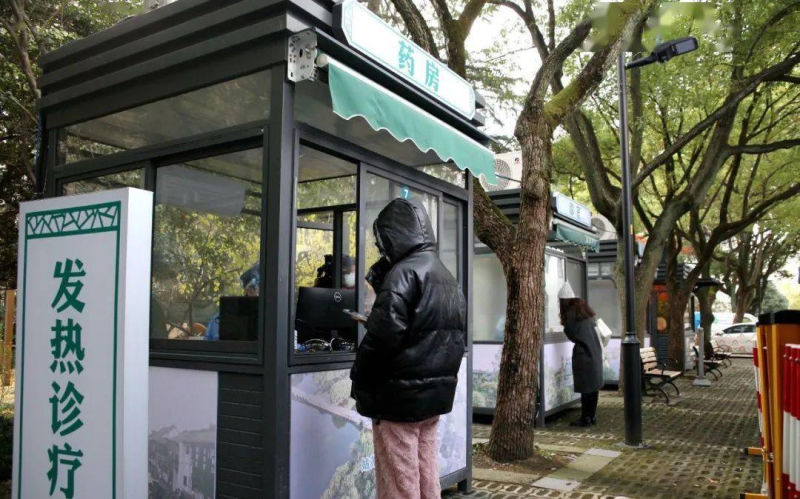
Via ‘copyquan’ republished on Sohu.
Blogger ‘copyquan’ recently explored various ways in which abandoned PCR testing points are being repurposed.
One way in which they are used is as small pharmacies or as medical service points for local residents (居民医疗点). Alleviating the strain on hospitals and pharmacies, this was one of the earliest ways in which the booths were repurposed back in December of 2022 and January of 2023.
Chongqing, Tianjin, and Suzhou were among earlier cities where some testing booths were transformed into convenient medical facilities.
2: Market Stalls
In Suzhou, Jiangsu province, the local government transformed vacant nucleic acid booths into market stalls for the Spring Festival in January 2022, offering them free of charge to businesses to sell local products, snacks, and traditional New Year goods.
The idea was not just meant as a way for small businesses to conveniently sell to local residents, it was also meant as a way to attract more shoppers and promote other businesses in the neighborhood.
3: Community Service Center
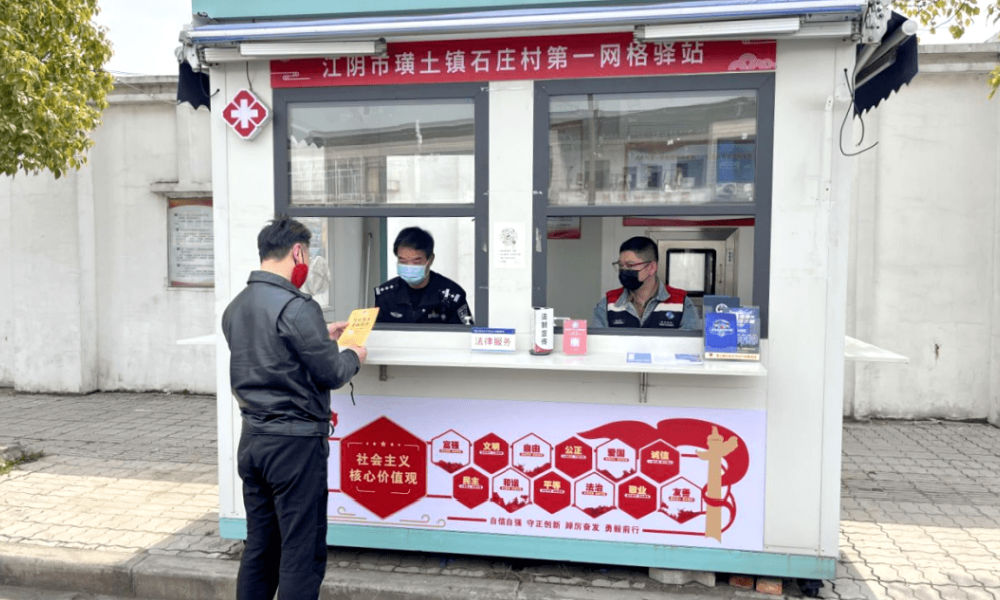
Small grid community center in Shizhuang Village, image via Sohu.
Some residential areas have transformed their local nucleic acid testing booths into community service centers, offering all kinds of convenient services to neighborhood residents.
These little station are called wǎnggé yìzhàn (网格驿站) or “grid service stations,” and they can serve as small community centers where residents can get various kinds of care and support.
4: “Refuel” Stations

In February of this year, 100 idle nucleic acid sampling booths were transformed into so-called “Rider Refuel Stations” (骑士加油站) in Zhejiang’s Pinghu. Although it initially sounds like a place where delivery riders can fill up their fuel tanks, it is actually meant as a place where they themselves can recharge.
Delivery riders and other outdoor workers can come to the ‘refuel’ station to drink some water or tea, warm their hands, warm up some food and take a quick nap.
5: Free Libraries

image via sohu.
In various Chinese cities, abandoned nucleic acid booths have been transformed into little free libraries where people can grab some books to read, donate or return other books, and sit down for some reading.
Changzhou is one of the places where you’ll find such “drifting bookstores” (漂流书屋) (see video), but similar initiatives have also been launched in other places, including Suzhou.
6: Study Space

Photos via Copyquan’s article on Sohu.
Another innovative way in which old testing points are being repurposed is by turning them into places where students can sit together to study. The so-called “Let’s Study Space” (一间习吧), fully airconditioned, are opened from 8 in the morning until 22:00 at night.
Students – or any citizens who would like a nice place to study – can make online reservations with their ID cards and scan a QR code to enter the study rooms.
There are currently ten study booths in Anji, and the popular project is an initiative by the Anji County Library in Zhejiang (see video).
7: Beer Kiosk

Hoegaarden beer shop, image via Creative Adquan.
Changing an old nucleic acid testing booth into a beer bar is a marketing initiative by the Shanghai McCann ad agency for the Belgium beer brand Hoegaarden.
The idea behind the bar is to celebrate a new spring after the pandemic. The ad agency has revamped a total of six formr nucleic acid booths into small Hoegaarden ‘beer gardens.’
8: Police Box

In Taizhou City, Jiangsu Province, authorities have repurposed old testing booths and transformed them into ‘police boxes’ (警务岗亭) to enhance security and improve the visibility of city police among the public.
Currently, a total of eight vacant nucleic acid booths have been renovated into modern police stations, serving as key points for police presence and interaction with the community.
9: Lottery Ticket Booths

Image via The Paper
Some nucleic acid booths have now been turned into small shops selling lottery tickets for the China Welfare Lottery. One such place turning the kiosks into lottery shops is Songjiang in Shanghai.
Using the booths like this is a win-win situation: they are placed in central locations so it is more convenient for locals to get their lottery tickets, and on the other hand, the sales also help the community, as the profits are used for welfare projects, including care for the elderly.
10: Mini Fire Stations

Micro fire stations, images via ZjNews.
Some communities decided that it would be useful to repurpose the testing points and turn them into mini fire kiosks, just allowing enough space for the necessary equipment to quickly respond to fire emergencies.
Want to read more about the end of ‘zero Covid’ in China? Check our other articles here.
By Manya Koetse,
Get the story behind the hashtag. Subscribe to What’s on Weibo here to receive our newsletter and get access to our latest articles:
Spotted a mistake or want to add something? Please let us know in comments below or email us. First-time commenters, please be patient – we will have to manually approve your comment before it appears.
©2023 Whatsonweibo. All rights reserved. Do not reproduce our content without permission – you can contact us at info@whatsonweibo.com.
Subscribe

Weibo Watch: The Future is Here

“Bye Bye Biden”: Biden’s Many Nicknames in Chinese

Enjoying the ‘Sea’ in Beijing’s Ditan Park

A Triumph for “Comrade Trump”: Chinese Social Media Reactions to Trump Rally Shooting

Weibo Watch: Get Up, Stand Up

The Tragic Story of “Fat Cat”: How a Chinese Gamer’s Suicide Went Viral

“Old Bull Eating Young Grass”: 86-Year-Old Chinese Painter Fan Zeng Marries 36-Year-Old Xu Meng

A Brew of Controversy: Lu Xun and LELECHA’s ‘Smoky’ Oolong Tea

Singing Competition or Patriotic Fight? Hunan TV’s ‘Singer 2024’ Stirs Nationalistic Sentiments

Zara Dress Goes Viral in China for Resemblance to Haidilao Apron

Weibo Watch: The Battle for the Bottom Bed

About the “AI Chatbot Based on Xi Jinping” Story

China’s Intensified Social Media Propaganda: “Taiwan Must Return to Motherland”

Weibo Watch: Telling China’s Stories Wrong

Saying Goodbye to “Uncle Wang”: Wang Wenbin Becomes Chinese Ambassador to Cambodia
Get in touch
Would you like to become a contributor, or do you have any tips or suggestions? Get in touch here!
Popular Reads
-
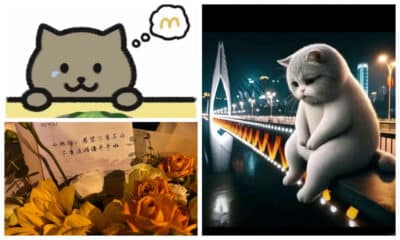
 China Insight3 months ago
China Insight3 months agoThe Tragic Story of “Fat Cat”: How a Chinese Gamer’s Suicide Went Viral
-

 China Music4 months ago
China Music4 months agoThe Chinese Viral TikTok Song Explained (No, It’s Not About Samsung)
-

 China Digital10 months ago
China Digital10 months agoToo Sexy for Weibo? Online Discussions on the Concept of ‘Cābiān’
-

 China Arts & Entertainment12 months ago
China Arts & Entertainment12 months agoBehind 8 Billion Streams: Who is Dao Lang Cursing in the Chinese Hit Song ‘Luocha Kingdom’?




